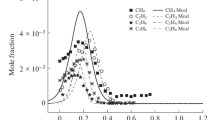Abstract
The possibility of reducing the concentration of nitrogen oxides and HNOx-group components with simultaneous shortening of the reaction-zone length during combustion of hydrogen-air mixtures in a supersonic flow behind an oblique shock wave by introducing NH3, CH4, and C2H6 additives into the mixture is analyzed. A numerical study shows that a small (up to 5%) amount of these additives substantially changes the combustion kinetics behind the shock-wave front, shortens the flame length, and diminishes the NO and NO2 content in the combustion products.
Similar content being viewed by others
References
M. G. Ostrander, J. C. Hyde, M. A. Yang, and R. O. Kissuger, “Standing oblique detonation wave engine performance,” AIAA Paper No. 87-2002 (1987).
H. S. Jonston, D. E. Kinnison, and D. J. Wuebbles, “Nitrogen oxides from high-attitude aircraft: an update of potential effects on ozone,”J. Geophys. Res.,7, No. D13, 16.351–16.363 (1989).
J. Maransi, “Reducing NOx emissions from today’s power plants,”Power, May issue, 11–28 (1993).
V. A. Pavlov and I. N. Shteiner,Optimization Conditions for Liquid-Fuel and Gas Combustion in Power Plants [in Russian], Énergoatomizdat, Leningrad (1984).
R. K. Lyon, “Method for the reduction of the concentration of NO in combustion effluents using ammonia,” Patent USA No. 3900544 (1975).
I. S. Zaslonko, A. M. Tereza, O. N. Kulish, and D. Yu. Zheldakov, “Kinetic aspects of reducing the nitrogen-oxide level in combustion products using ammonia (De-NOx) additives,”Khim. Fiz.,11, No. 11, 1491–1517 (1992).
N. G. Dautov and A. M. Starik, “Effect of nonequilibrium phenomena in scramjet components on formation of ecologically hazardous gas components,”Teplofiz. Vys. Temp.,33, No. 2, 279–287 (1995).
T. C. Yip, “Ignition delay and characteristic reaction length in shock-induced supersonic combustion,” AIAA Paper No. 89-2567 (1989).
N. G. Dautov and A. M. Starik, “Numerical study of detonation in CH4(H2) + air mixtures behind shock waves,”Fiz. Goreniya Vzryva,32, No. 1, 94–110 (1996).
W. Tsang and J. T. Herron, “Chemical kinetic data base for propellant combustion. I. Reactions involving NO, NO2, HNO2, HCN, and N2O,”J. Phys. Chem., Ref. Data,20, No. 4, 609–663 (1991).
M. V. Kantak, K. S. Manrique, R. H. Aglave, and R. P. Hesketh, “Methylamine oxidation in a flow reactor: Mechanism and modeling,”Combust. Flame,108, Nos. 1/2, 235–265 (1997).
B. A. Williams and L. Pasternack, “The effect of nitric oxide on premixed flames of CH4, C2H6, C2H4, and C2H2,”Combust. Flame,111, Nos. 1/2, 87–110 (1997).
Author information
Authors and Affiliations
Additional information
Translated fromFizika Goreniya i Vzryva, Vol. 36, No. 3, pp. 31–38, May–June, 2000.
This work was supported by the Russian Foundation for Fundamental Research (Grant No. 96-02-18377).
Rights and permissions
About this article
Cite this article
Starik, A.M., Titova, N.S. Numerical analysis of combustion kinetics for hydrogen—air mixtures with NH3, CH4, and C2H6 additives behind shock waves. Combust Explos Shock Waves 36, 310–317 (2000). https://doi.org/10.1007/BF02699382
Received:
Issue Date:
DOI: https://doi.org/10.1007/BF02699382




